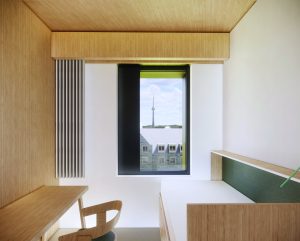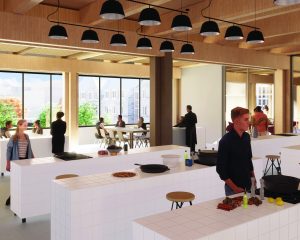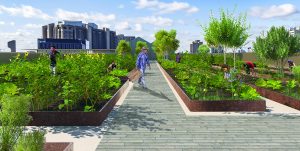The Visionary Campus
By Cynthia Macdonald
Thirty years ago, Trinity students had less to worry about than their Generation Z counterparts. Over the next decade, young Canadians will find themselves grappling with a multitude of sobering new realities: recurrent threats to public health, a climate in crisis, and escalating uncertainty in job and housing markets—to name but a few.
And yet, the future is bright. As we progress towards 2030, students at Trinity will have increasing access to services that were the stuff of mere fantasy three decades ago. The way our students live, socialize, study and plan for their futures is now being adapted to help students start creating meaningful change and lead happy lives well before they graduate.
Centered around a vibrant new building—the Lawson Centre for Sustainability—Trinity is consistently meeting new challenges in a positive way, setting an example for students and the world they are soon set to enter. At Trinity, public health, environment, diversity, housing and work are not problems to be feared, but challenges to be tackled. It’s a new kind of campus: a visionary campus.
Let’s time-travel to 2027, and take the example of a typical Generation Z student—call her “Zoe.” An aspiring environmental lawyer, the second-year student is already getting periodic career advice from a Generation X alumna (“Xena”) who has herself enjoyed a long and successful career in the same field. The two met through ConnecTRIN, an online portal that offers a range of networking opportunities to both students and alumni.
Over coffee at the Reunion gathering, Xena regales Zoe with stories about student life at the dawn of the Internet. Back then, she was an International Relations major who cared deeply about the destruction of old-growth forests, overseas conflict in Rwanda and the former Yugoslavia, and the search for an AIDS vaccine. The world was rife with problems calling out for solutions, but a true sense of optimism and hope permeated all of Xena’s discussions on these topics—whether they were conducted through vigorous classroom debates, around tables at the Buttery, or in late-night arguments while listening to Pearl Jam CDs in residence at St. Hilda’s.
“And what about you, Zoe?” Xena asks. “What’s student life like these days?”
“Pretty great!” replies Zoe enthusiastically. “Let me tell you all about it.”
A Day in Zoe’s life, 2027
7:30 A.M.
Natural light streams into Zoe’s residence room in the Lawson Centre for Sustainability as she rises to begin her day. The room is bright and welcoming, with locally sourced wood floors and furnishings and larger-than-average insulated windows. The residence, like the whole building, is a “living lab” where every detail reflects sustainable principles—from geothermal heating and cooling to solar panels and a green roof. It provides a model for how Zoe and her peers would like to live not just now—but always.
Zoe grew up out of province, and she and her classmates are especially grateful for the security of a spacious, comfortable residence room: off-campus housing continues to be scarce and expensive in big cities like Toronto.
At other universities, the students of 2027 have been required to take part-time jobs to pay rent, cutting into the time they spend studying and socializing. But with the Lawson Centre’s extra residence beds, fully 40 percent of first- and upper-year Trinity students are now able to live on campus, in rooms spacious enough to allow for physical distancing when necessary. It’s a figure comparable to the days when Xena happily dwelt in her home base at St. Hilda’s.
Since she first enrolled in the Butterfield Environment & Sustainability Stream, Zoe has long been conscious of how environmental activism begins in the home (she badgered her mother to buy water-conserving shower heads, for example.) In this respect, the Lawson Centre is actually her dream home.

8:15 a.m.
Before starting class, Zoe descends to the cafeteria to meet her classmates Johnny, Binh and Sara for breakfast. As usual, Johnny gets there first. Like more than half of Trinity students, he’s a commuter; while many others take public transit to school, Johnny happens to be a cyclist. Fortunately, Trinity now provides him with ample storage space to keep his bike safe.
He and his fellow commuters are welcome at any time at the Lawson Centre, which offers them ample space to study, socialize—and stay over if need be, in rooms designed expressly for that purpose. In that way, they can feel as connected to the College as their residence-based friends.
The four students follow different diets: Zoe and Sara are vegans, while Johnny is vegetarian and Binh eats meat. The cafeteria easily meets all their dietary requirements—and with each meal, all four are able to enjoy meals prepared using locally sourced produce.
Living in the Lawson Centre, the students have definitely become more mindful of what they eat. In their spare time, they have been involved in preparing their own meals through Trinity’s community kitchen program, which hosts cooking classes and workshops on nutritious, sustainable eating.
Trinity also features an urban agriculture program, which allows students to grow, tend and harvest food right in the heart of the city.
The lessons Zoe has learned here—about urban agriculture, advanced composting technologies and energy-efficient waste disposal—have all complemented her classroom work. A bonus? She has also learned how to cook.



9:00 a.m.
Sara winces impatiently. “Zoe, take that bagel with you! Class is starting.”
While Johnny is earliest to the cafeteria, Sara is usually the first one to take her seat in one of the Lawson Centre’s fully equipped new seminar rooms (added pursuant to a vast expansion in teaching space at Trinity.) Like 20 percent of Trinity students, Sara is the first in her family to ever attend university: Education is not something she ever takes for granted. In high school, she wondered if her dream of studying immunology might ever be possible.
Thanks to a generous bursary, however, she is on track to enrol in that department’s specialist program, which will enable her to complete the first step towards helping to protect society against the threat of further pandemic disease. The program, which Trinity sponsors on behalf of the Faculty of Arts & Science, has understandably attracted an unprecedented level of recent student interest. Its competitive nature ensures that only the most accomplished and committed are now enrolled.
It is worth noting that Sara is far from alone: With economic distress resulting from the pandemic that shadowed their childhoods, half of Trinity students require some form of economic assistance in 2027. It’s important to the College that such assistance is readily available.
10:00 a.m.
The lecture portion of Zoe’s seminar class is finished, and she adjourns to a large study area with a group of three other students. In their Pathways to Sustainability class, the group is researching how microplastics have affected biodiversity in the great lakes. Along with library research, the group has been interviewing biologists and environmentalists in preparation for a field trip to U of T’s Koffler Scientific Reserve. They also get help from older undergraduates in the program.
Zoe’s educational experience extends far beyond the classrooms and libraries of Xena’s day; with extensive fieldwork and the opportunity to meet and discuss her ideas with visiting lecturers and more experienced students, she is developing connections to the world outside long before graduation—something that will prove critical in a difficult job market.
11:15 a.m.
Zoe rushes to the main building on Hoskin Avenue for a meeting with a learning strategist at the Student Services Centre. Since entering university, she has struggled somewhat with the demands of balancing coursework and extracurricular activities. At other times, the Centre has also provided valuable writing support when she’s needed help constructing cogent essay arguments.
The Student Services Centre has become a true lifeline at Trinity. All of Zoe’s friends use it, for a variety of reasons. Concerned about their futures while at Trinity and beyond, the students will regularly meet with a Career and Academic Advisor who can advise them about their educational and professional options.
This is also where Sara consults on her options for financial support; and where Binh has access to in-house mental health and wellness counselling—services that include the addition, in 2016, of the Anne Steacy Counselling Initiative. Trinity’s mental health supports have accelerated with anxieties caused by the pandemic and recession, and the maintenance of mental health and wellness programming has become a top priority at the College. Preventing problems before they become serious is of paramount importance.
Like more than 20 percent of his Trinity cohort, Binh is an international student. Dealing with the twin pressures of homesickness and adjusting to a new culture has added immeasurably to the stresses of his new academic life. One of the key aims of Trinity’s mental health program is to identify the particular needs of students like Binh, and to help them feel safe and comfortable while living in a new country.
2:00 p.m.
Crossing the Quad, Zoe finds herself dissolving in laughter with another knot of close friends, with whom she’s been planning a winter getaway. Clubs, as well as literary and artistic endeavours, are a cherished feature of the Trinity landscape. While the College regularly stimulates students to solve world problems, it also helps them to find—when needed—an authentically comforting refuge from them.
3:00 p.m.
Zoe has always loved travelling: As a teenager, prior to the pandemic, she had the good fortune to make a trip to Peru. There, she worked on the ecological refit of a hospital located on the border of a rainforest. She made a film about the experience, which Adil is helping her to edit after a late lunch in the cafeteria. The two plan on screening it outdoors later in the year, under the auspices of the Trinity Environmental Club.
Since Xena’s day, the College has grown ever more diverse, in terms of interests, ethnicity, gender and sexual identity. Consequently, the Student Services Centre is where Trinity students from all backgrounds can also get information about where they can find clubs, groups, and “homes within homes” while at university. As new needs arise on suggestions by the students, the Centre has proven itself to be a responsive, flexible hub for all their concerns.
4:15 p.m.
The Lawson Centre has allowed not only for an expansion of teaching space, but office space as well. Consequently, it’s easy for Zoe to fit in a meeting with one of her professors before her final class of the day. Trinity’s faculty has always been the “soul of the College”; with a renewed emphasis on seeking out the best and most innovative of thinkers, Zoe is able to learn not only from the best, but the most original and forward-thinking professors possible.
7:30 p.m.
After an early supper in Strachan Hall, Zoe, Johnny, Binh and Sara take the energy-efficient elevator upstairs to listen to tonight’s speaker, a visiting global health expert from Kenya. Naturally, aspiring immunologist Sara is keen to hear what he has to say. It’s notable that his subject is inextricably tied to topics studied by all the group.
While “sustainability” connotes a deep commitment to environmental health, it is never divorced from economic or human considerations. In one way or another, the students have all been studying its aims since they first started in their respective programs.
This is why frequent visits by distinguished speakers at Trinity routinely attract a College-wide audience. When federal cabinet ministers are invited by the Bill Graham Centre for Contemporary International History, or philosophers address those in Ethics, Society & Law, everyone is welcome to hear their views. This way, all students acquire an extracurricular education that is both well-rounded and interdisciplinary.
Tonight’s speaker discusses how recent research into anti-viral vaccines has had an additional effect on crop preservation and food security—and he just happens also to be a Trinity alumnus. At the lively reception afterward, Zoe, Johnny, Sara and Binh are all invited to ask questions and posit solutions. The shared experience of having a Trinity education adds a special feeling of connection between the students and their visitor.
***
Back at Reunion, it’s 10 p.m. and things are wrapping up for the evening.
Listening to Zoe, Xena marvels at how her beloved alma mater has changed. Fresh, locally grown food… flooring and furniture sourced from local forests… giant windows with natural light, counselling for every concern, outdoor movie screenings and a wide range of international speakers. Xena realizes the College has come a long way—in a good way. It makes her all the more excited and proud to have returned for Reunion.
At the same time, she realizes that with its focus on community spirit, establishing lifelong friendships and collective problem-solving, the old Trinity is very much like the new. Its students have always been conscious, serious and caring; current times demand that they be even more so. Xena’s generation, like those that came before, laid the foundations for their successors by encouraging early environmental initiatives, intergenerational exchange and a whole host of social activities designed to foster lifelong friendships.
Now, a growing awareness of modern challenges has presented the whole Trinity community with an opportunity to create a campus that is even more inclusive, welcoming, caring and sustainable than ever. It’s a model for the future—built on lessons from the past.
“Trinity’s just a great place to be,” Zoe smiles.
“And a great place to come back to,” adds Xena.
As published in Trinity Magazine Fall 2020

Sorry, comments are closed for this post.